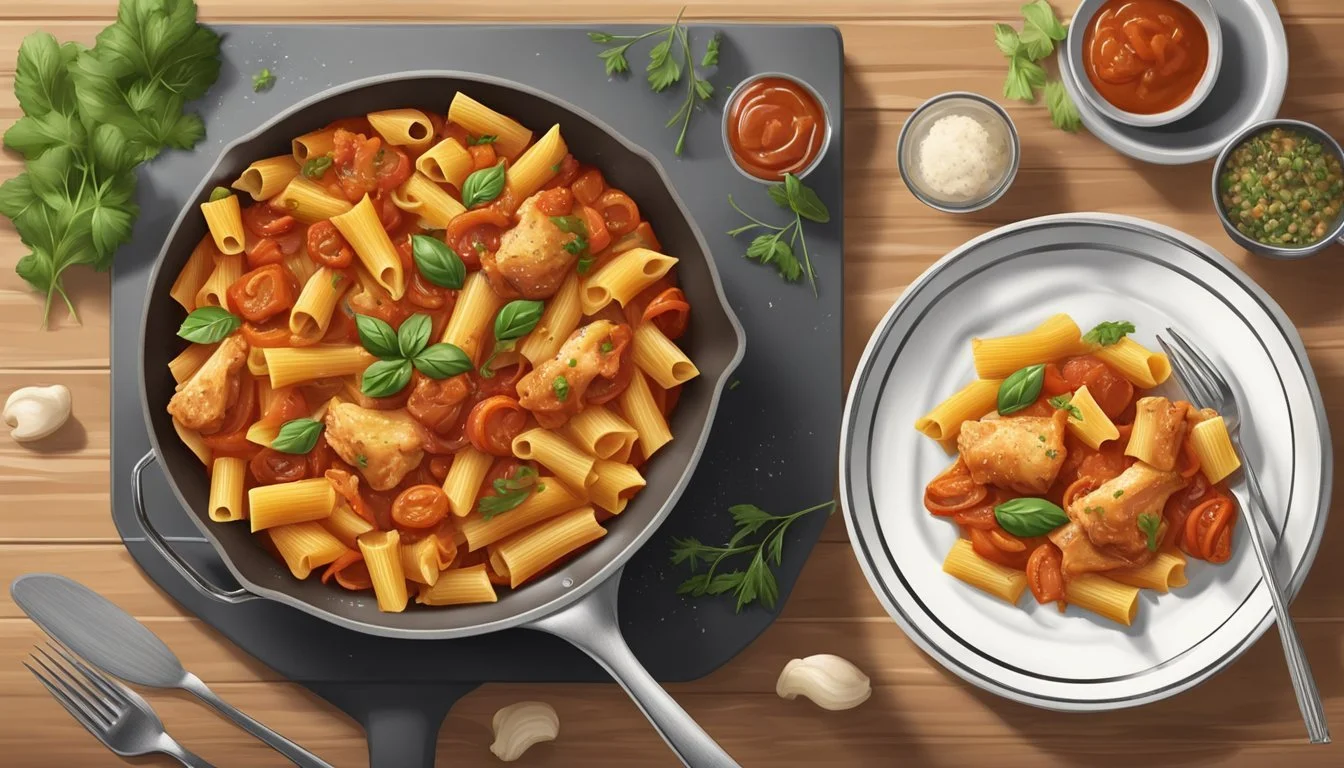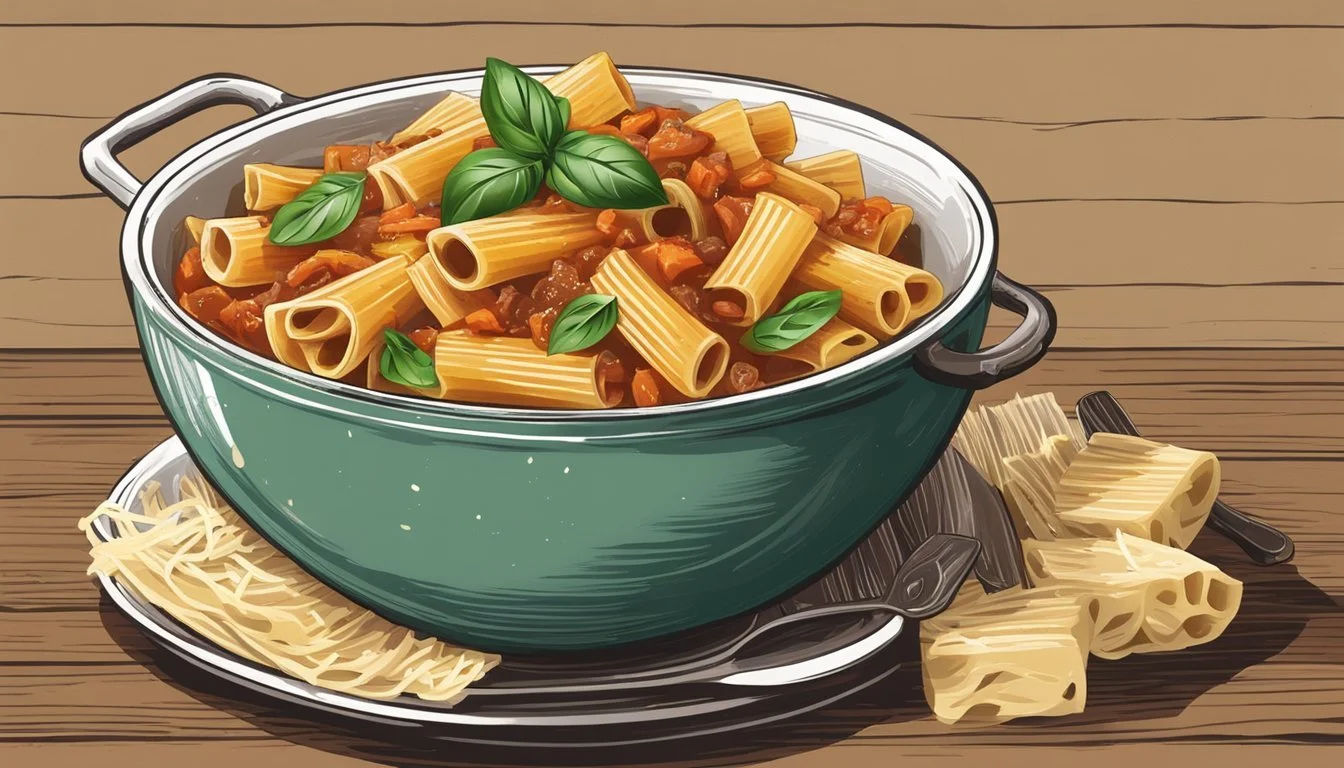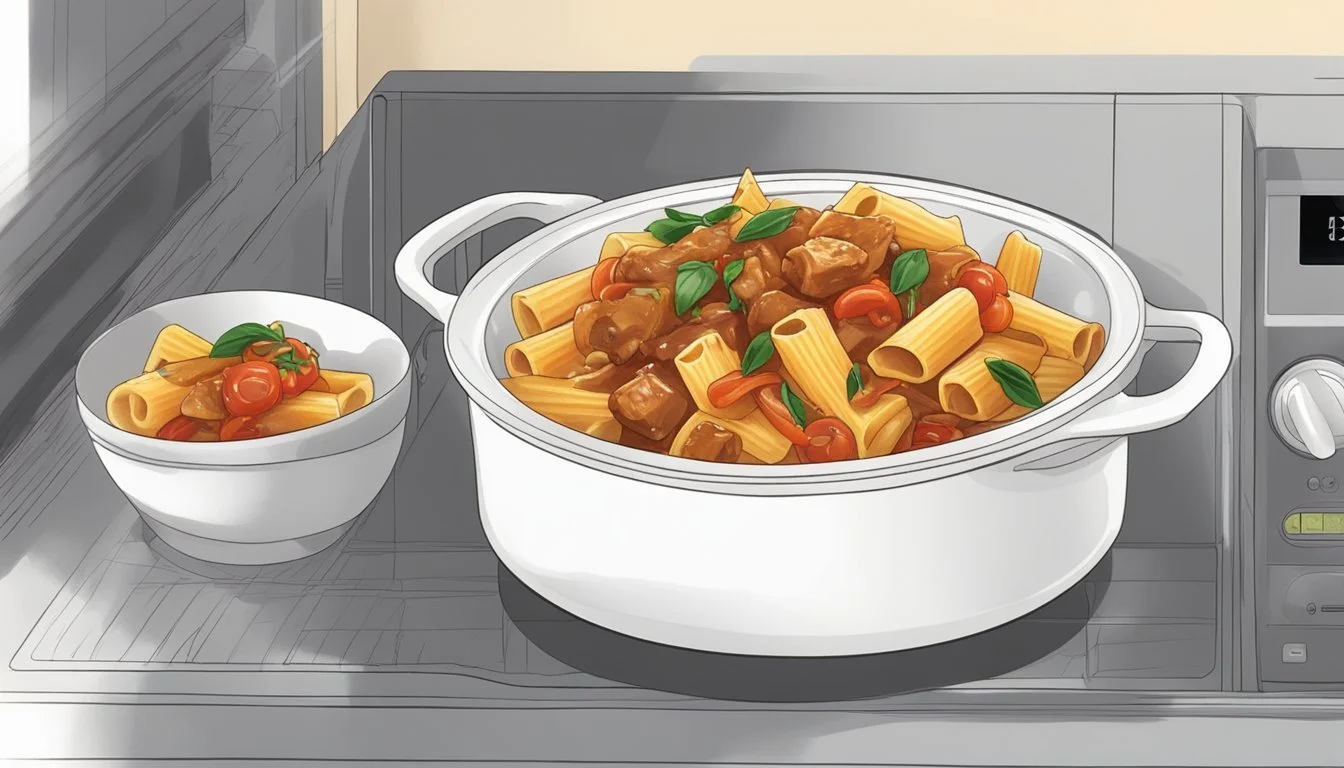Best Way to Reheat Rigatoni with Chicken Cacciatore
Ensuring Perfect Texture Every Time
Reheating dishes like rigatoni with chicken cacciatore (What wine goes well with chicken cacciatore?) presents a unique challenge: keeping the pasta (What wine goes well with pasta?) al dente while ensuring the chicken remains tender. Achieving this balance requires understanding the distinct characteristics of the dish. Chicken cacciatore, a rich and rustic Italian stew, is typically made with a tomato-based sauce and can be heavy on the herb and vegetable content, while rigatoni is a pasta known for its ridges that hold sauces well. When combining these two, the goal is to restore the meal's texture and flavors as if freshly made.
The approach to reheating must factor in the different components of the dish. It involves gently warming the chicken to avoid it becoming tough and thoroughly heating the pasta without it becoming too soft. Techniques vary from using the microwave with care to employ gentle heat on the stovetop. This process preserves the quality of each ingredient and ensures that each bite is as delightful as when the dish was first prepared. Methods for reheating take into account the time the food was stored, the original cooking methods, and the desired outcome of preserving the integrity of the rigatoni and chicken cacciatore's textures and flavors.
Understanding Rigatoni and Chicken Cacciatore
In the realm of Italian cuisine, rigatoni paired with Chicken Cacciatore stands out for providing a harmonious blend of texture and flavor. The dish is an exercise in balancing the hearty bite of pasta with the rich, herby sauce enveloping tender pieces of chicken.
The Profile of Rigatoni
Rigatoni is a tube-shaped pasta known for its ridges and larger size, which allows it to hold sauces well and provide a pleasant mouthfeel. Here's its character in a nutshell:
Shape: Tubular with ridges
Texture: Ideal for al dente cooking
Sauce compatibility: Excellent for thick, chunky sauces
One of the key aspects of rigatoni is its ability to stay al dente, which is the point where pasta is cooked to be firm to the bite. This is crucial when reheating to maintain its texture and prevent it from becoming mushy.
Chicken Cacciatore: A Classic Italian Dish
Chicken Cacciatore, which translates to "hunter's chicken" in Italian, is a hearty stew that combines chicken with a robust sauce. The sauce usually consists of the following:
Base ingredients: Tomatoes and olive oil
Herbs: Rosemary, oregano, thyme, and basil
Protein: Chicken, cooked until tender
Chicken Cacciatore typically involves browning chicken pieces in olive oil, then simmering them in a sauce made with tomatoes, aromatic herbs, and sometimes wine, onions, and bell peppers. The dish is a staple of Italian comfort food and enjoys a reputation for its warming and satisfying qualities.
Ingredients Synergy in Cacciatore
The compatibility between rigatoni and Chicken Cacciatore lies in the way the pasta absorbs the flavors of the sauce without overwhelming the protein. The olive oil in the sauce plays an essential role in delivering flavor and maintaining the right texture for both the pasta and the chicken. The fresh herbs used in Cacciatore add depth to the dish, while tomatoes provide acidity that balances the rich flavors. This synergy is what makes rigatoni with Chicken Cacciatore not just a meal, but an experience.
Initial Preparation and Cooking
The key to achieving perfectly al dente rigatoni and tender chicken cacciatore lies in the careful initial preparation and cooking. Following precise steps ensures that the pasta holds its shape and texture while the chicken remains succulent, setting the foundation for a successful reheating process.
Cooking Rigatoni to Al Dente
To cook rigatoni to al dente:
Boil 4 quarts of water for every pound of pasta.
Once boiling, add 2 tablespoons of salt to the water.
Add the rigatoni and stir occasionally to prevent sticking.
Cook according to package instructions, usually for about 12 minutes. Checking a piece of pasta one minute before the suggested time can help prevent overcooking.
Drain and toss with a bit of olive oil to keep the pasta from clumping together as it cools.
Preparing the Chicken
For tender chicken:
Choose bone-in, skin-on chicken thighs for maximum flavor and moisture retention.
Pat the chicken dry, season with salt and pepper, and dredge lightly in flour.
In a skillet, heat a generous amount of olive oil over medium-high heat.
Sear the chicken thighs until golden brown, typically about 4-5 minutes per side.
Remove the chicken and set aside, retaining the juices in the pan.
Combining Ingredients
When combining rigatoni and chicken:
In the same skillet used for chicken, sauté chopped onions and sliced mushrooms.
Once the vegetables are softened, deglaze the pan with a splash of wine, scraping up any flavorful bits.
Add a rich broth and bring to a simmer, then return the seared chicken thighs to the pan.
Cover and let simmer until the chicken is thoroughly cooked and the flavors have melded, about 30-40 minutes.
The pasta is added last, tossed gently with the chicken, and heated through before serving to maintain its al dente texture.
Proper Storage Techniques for Leftovers
Ensuring that leftovers, particularly rigatoni with chicken cacciatore, retain their quality involves careful cooling and packaging, followed by proper refrigeration. This section will guide you through the steps to maintain the al dente texture of your pasta and the tenderness of your chicken when stored.
Cooling Down and Packaging
Leftovers should be cooled down to room temperature before storage. The pasta sauce should not sit out for more than 2 hours to prevent bacterial growth. For proper cooling, one should spread the rigatoni with chicken cacciatore on a shallow dish.
Packaging:
Wrap the dish tightly with aluminum foil or transfer the contents into an airtight container.
IfSeparate the leftover pasta from the sauce when possible to prevent the rigatoni from continuing to absorb moisture and becoming soggy.
Refrigeration Best Practices
Once cooled and packaged, leftovers require proper refrigeration to maintain freshness and prevent spoilage. Here are key considerations:
Refrigerator temperature should be set below 40°F (4°C).
Store the packaged leftovers in the coldest part of the refrigerator to discourage bacterial growth.
Leftover pasta and chicken should be consumed within 3-4 days for best quality.
Reheating Procedures for Optimal Quality
The key to reheating Rigatoni with Chicken Cacciatore lies in preserving the pasta's al dente texture and ensuring the chicken remains tender. Below are the recommended procedures for oven and stovetop reheating that focus on even distribution of heat and maintenance of moisture.
Oven Method for Even Heating
Using the oven for reheating provides a gentle, even heating process that is less likely to overcook the pasta or chicken. Here are the steps:
Preheat the oven to 350°F (175°C).
Place the Rigatoni with Chicken Cacciatore in a baking dish.
Cover the dish with aluminum foil to retain moisture and heat evenly.
Reheat for about 10-15 minutes. Check the dish to ensure it is heated through to the center.
If additional heating time is needed, do so in 5-minute increments to avoid drying out the pasta and chicken.
Stovetop Reheating for Convenience
The stovetop method offers quick reheating and allows for more control over the temperature, which is crucial for not overcooking the ingredients. To reheat using the stovetop:
Transfer the Rigatoni with Chicken Cacciatore to a skillet or pan.
Add a splash of broth or water to the pan to provide moisture and prevent the pasta from drying out.
Heat the dish on the stovetop over a medium-low setting for even heating.
Stir occasionally to distribute the heat and keep the pasta from sticking.
Allow the dish to heat for about 5-7 minutes, ensuring the chicken is heated through but remains tender.
Additional Tips and Variations
When reheating rigatoni with chicken cacciatore, one should ensure the pasta retains its al dente texture and the chicken remains tender. The following subsections present specific advice on enhancing flavors and offering alternative serving suggestions.
Enhancing Flavors Post-Reheating
Ingredients to Add:
Fresh Herbs: Incorporating herbs like oregano and basil can refresh the dish's palate.
Vegetables: Adding sautéed bell peppers, yellow onion, and carrots can enhance flavor and texture.
Tips:
Drizzle extra virgin olive oil over the dish to add depth and richness.
A pinch of freshly ground pepper can elevate the overall flavor profile.
Alternative Serving Suggestions
For a Twist:
Serve with a garnish of olives (What wine goes well with olives?) and zucchini for a Mediterranean flair.
Top with roasted garlic cloves or a spoonful of caramelized onions for added sweetness and complexity.
Presentation:
Plate with a side of grilled vegetables (What wine goes well with grilled vegetables?)to balance the dish.
Consider a light drizzle of infused oils or tossing with freshly grated cheese for finishing touches.
Serving and Presentation
When serving rigatoni with chicken cacciatore, one should focus on maintaining the pasta's al dente texture and the chicken's tenderness. Presentation is key in enhancing the dining experience. It’s essential to use the right plating techniques and garnishing to underscore the dish's Italian roots.
Plating Techniques
To plate rigatoni with chicken cacciatore effectively, one should start with a warmed plate to keep the dish at an optimal temperature. They should lay out a base of rigatoni, ensuring that the portion is ample but not overcrowded. Afterwards, they thoughtfully place pieces of tender chicken cacciatore on top of the pasta bed.
The sauce should be ladled over the pasta and chicken, allowing it to pool slightly around the edges of the plate. This showcases the ingredients while also keeping everything moist. A chef recommends arranging the chicken and pasta in a way that reveals the different components, hinting at the layered flavors within.
Garnishing for Appeal
Garnishes are more than just decorative; they're a way to add subtle flavor hints and eye appeal. The chef should sprinkle finely chopped parsley or basil on top of the dish right before serving to introduce freshness and a pop of color. A sprig of rosemary or a light dusting of Italian seasoning can enhance the aroma and invite the first bite.
Another option is to offer a small bowl of extra herbs along with a grater and a block of Parmesan cheese, allowing diners to add to their taste and engage with their meal actively.
Using these techniques, the chef ensures every serving of rigatoni with chicken cacciatore is as pleasing to the eye as it is to the palate.
Dietary Considerations and Substitutions
When reheating rigatoni with chicken cacciatore, it’s important to maintain the integrity of the dish while catering to diverse dietary needs. Gluten-free and vegetarian modifications are straightforward adaptations that can be made without compromising on taste or texture.
Gluten-Free Alternatives
For individuals who are gluten-sensitive or have celiac disease, the rigatoni can be substituted with gluten-free pasta made from rice, corn, or a blend of gluten-free flours. When selecting a gluten-free pasta for reheating, it's crucial to choose a variety that holds up well to reheating without becoming mushy. Instead of traditional all-purpose flour, one can use a gluten-free all-purpose flour blend for thickening the sauce if needed.
Vegetarian Modifications
To transform the chicken cacciatore into a vegetarian-friendly dish, one may consider using hearty vegetables or plant-based proteins in place of the chicken. Some suitable substitutions include:
Mushrooms (such as portobellos or creminis) for their meaty texture.
Tofu or tempeh, which should be sautéed or baked until crisp before adding to the sauce.
Lentils that add protein and substance to the dish without altering the sauce's consistency drastically.
For vegan modifications, ensure that the pasta is egg-free and opt for vegan cheese or nut-based parmesan as a garnish instead of traditional cheese.
Handling Leftovers: Do's and Don'ts
When preserving the texture of rigatoni and ensuring chicken remains tender when reheating, it is important to follow some key guidelines.
Do:
Use the Right Containers: Always reheat rigatoni with chicken cacciatore in microwave-safe dishes to avoid any health hazards.
Cover with a Paper Towel: This will help absorb excess moisture and prevent the pasta from getting too soggy.
Employ Aluminum Foil for Oven Reheating: If using an oven, wrap the rigatoni and chicken in aluminum foil to keep the dish moist and prevent the chicken from drying out.
Don't:
Overheat: Take care not to overheat the dish as it can lead to dry chicken and mushy pasta.
Use High Heat in a Microwave: Reheat in short bursts at medium power to maintain the dish's integrity.
Forget to Stir: If using a microwave, pausing to stir the rigatoni and chicken can ensure even heating.
Method Instructions Microwave Medium power, small bursts, stir intermittently, cover with paper towel Oven Low temperature (275°F), wrapped in foil, heat until just warm
They should remember to distribute leftovers in a way that allows for even reheating. Large clumps of pasta or chicken might lead to unevenly heated portions where some parts are hot, and others are still cold. By observing these practices, one ensures the reheated rigatoni with chicken cacciatore is as close to freshly made as possible.
Conclusion
Reheating rigatoni with chicken cacciatore requires attention to detail to maintain the dish's quality. To ensure the pasta remains al dente and the chicken stays tender, one should consider appropriate reheating techniques. Microwave reheating is suitable for convenience, with careful monitoring to avoid overcooking. Cover the dish while microwaving to retain moisture, and heat in short intervals.
For stovetop reheating, adding a little chicken broth can keep the rigatoni moist. Simmering on medium-low heat with occasional stirring promotes even distribution of warmth without reducing the pasta to a mushy texture. One can introduce fresh herbs or grated cheese towards the end to enhance the dish's flavor.
Using a combination of these methods allows for a meal that is both enjoyable and close to its original state. Patience and gentle reheating are key—heating dishes like rigatoni with chicken cacciatore slowly prevents drying out and assures the textures and flavors are preserved as intended.






